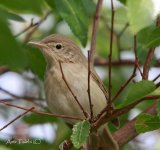Brian, in response to your question...I have extremely limited experience of the rarer unstreaked acro/hippo brigade. The very sight of a bland faced warbler always concentrates the mind, once Garden Warbler has been eliminated.
Clearly, I've not had your apparent experience concerning the 'latter'.
On a previous occasion I observed a BRW that according to text should have had the lower mandible diffusely tipped darker, which the bird did not have! Thus I call into question the absolute relevance of this cosmetic aid when dealing with scarce/rare bland migrants, prefering to address more fundamental issues...utc's, wing formula, overall cosmetics, behaviour(jizz)
vocal (if any) etc.
I've only ever seen one definite Booted Warbler, which I ascribed to the race caligata. This was due to the cosmetics/structure ticking all the boxes, with contrasting dark feet and a modestly sized bill....and lest I forget, observed at c8' from above.
If I may return the question....What's your opinion of the priority relevance, concerning diffusely tipped lower mandibles and the light-dependant extent of the rear supercillium...when your looking for a terminal clinch?
cheers




